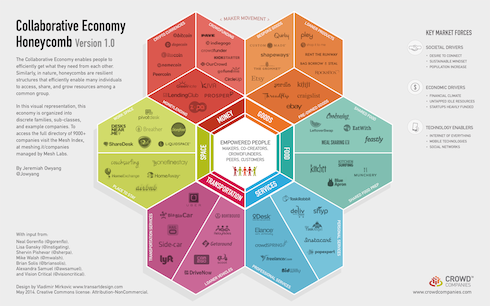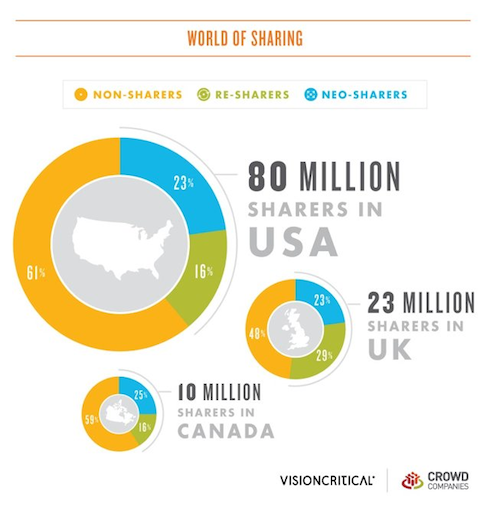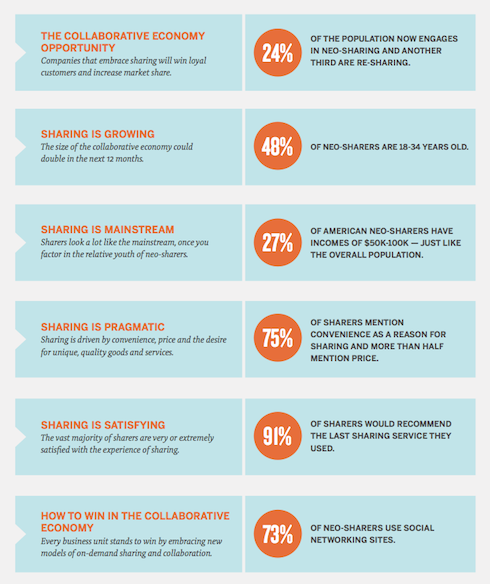Incite Group is now Reuters Events - LEARN MORE
By adaptive - May 27th, 2014

Social media connects people, their skills, goods and services together into a new ecosystem that is resulting in a new collaborative space.
How your corporation’s customers gain the goods and services they buy has radically shifted. The Internet delivered a completely new channel with m-commerce set to eclipse the massive rise of e-commerce. However, it’s social media that has had the most profound impact on how consumers relate to the brands they buy from, and how they leverage their social media networks in the purchase funnel.
The collaborative economy uses the concepts of crowd funding, the maker movement and the powerful recommendation economy to create a new ecosystem where the simple purchase of goods and services is being disrupted. Jeremiah Owyang calls this change the ‘collaborative economy’ stating that the crowd is becoming and behaving more like a company.
Sharing is the new buying
The mass of connections that social media has delivered means the mechanism used to reach sellers of goods and services are now longer controlled by corporations and their brand partners. Businesses need to understand how this shift is evolving and what their future role will be. In a world where consumers buy from each other, how can corporations ensure they have a role in this relationship?
In their new report into this phenomenon, Vision Critical state: “The collaborative economy isn’t simply a new way of buying or selling: it’s a powerful movement in which people are getting goods and services from each other (what people call the “sharing economy”), or even making them outright (also known as the “maker movement”). Just as social media enabled peer-to-peer sharing of content, the technologies of the collaborative economy now enable peer-to-peer sharing of goods, services, transportation, space and money at a speed and scale that were unimaginable a decade ago.”
There are three distinct groups identified as key players in the collaborative economy:
Non-sharers
These are people who have yet to engage in the collaborative economy. But many of them intend to try sharing services in the next 12 months, so they are a key target audience for both established businesses and sharing startups. They make up roughly 60% of the US and Canadian population and 48% of the UK.
Re-sharers
They buy and/or sell pre-owned goods online using well-established services like eBay and Craigslist. While many of them intend to try other kinds of sharing in the next 12 months, they have not done any “neo-sharing” in the past 12 months. They account for 16% of the US and Canadian population and 29% of the UK.
Neo-sharers
They are already using emergent sharing services: in the past 12 months, they have used at least one of the latest generation of sharing sites and apps, like Etsy, TaskRabbit, Uber, Airbnb and KickStarter. Neo- sharers now constitute 23% of the population in the US and the UK and 25% in Canada.
For brands this move to an economy where consumers can obtain what they want from each other could be seen as a worrying development. However, as consumers now share vast amounts of information across their social media networks, it was inevitable that they would eventually begin to use these networks to buy goods and services from trusted individuals. This shift does though, represent a massive commercial opportunity for brands.
The Vision Critical report continues: “The good news for established businesses is that the collaborative economy is still in its early days: no category of neo- sharing enjoys the participation of more than 10% of the population. But together, they’ve won the business of a quarter of the population and that quarter—the neo-sharers—are trying more and more forms of sharing all the time. That means that companies have a narrow window in which to win the hearts of sharers.
“Drive sharing with social media marketing, brands can use sharers’ propensity for social networking to ignite the virtuous circle between high customer satisfaction and recommendations. Because such a high percentage of sharers use social networking on a regular basis (73% of neo-sharers and 66% of re-sharers, compared with just 55% of non-sharers), brand marketers can use social media marketing tactics to drive the growth of sharing services. The popularity of photo sharing among re-sharers and neo-sharers suggests that it may be particularly effective to get people to promote their positive sharing experiences by posting photos.”
Brands then have a place in this new environment if they can develop lasting and trusted relationships with their customers. Corporations and their brand partners have learnt that personalisation coupled with deep relationship building leads to longevity with their consumers. Social media has presented a new layer to these communications. In many ways the collaboration economy is a product of social media that new companies will clearly exploit as the rules of engagement are defined.
Vision Critical conclude: “While the speed and scale of the transformation required may seem daunting, they are also what makes the collaborative economy so exciting to businesses and sharers alike. In many ways, the collaborative economy resolves the core tension that the business world has grappled with for nearly two hundred years: how to balance the competitive opportunities of large-scale production with consumer and employee expectations for agency and autonomy.
“The internet and particularly social media, have heightened that tension, both by making it possible to increase the scale of production (thanks to network-enabled integration across companies and countries) and by intensifying consumer expectations for responsiveness in the companies they work with or buy from.”
Next Reads
November 2014, New York
The Social Media for Customer Service Summit is your one-stop-shop for all the latest social media insight and best practice. It gives you a 360 degree look into building, operationalizing and initiating a successful social media strategy at your company
Brochure Programme



